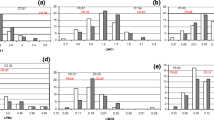Abstract
A segregating population derived from a cross between L. esculentum cv Madrigal and a line of L. pimpinellifolium was used to identify genetic markers linked to QTLs involved in salinity tolerance in terms of yield, under a conductivity of 15 dS/m (171.1 mM NaCl). Six markers resulted, associated with QTLs affecting average fruit weight, fruit number and total weight under salinity. One of them, Aco-1, behaves reversely to the expectation from parental means; this and other features make it a promising target to obtain salt-tolerant tomatoes. Epistatic interactions were also found, thus affecting the criteria for marker-assisted selection. Although only 41% of the loci assayed were polymorphic, a high efficiency in identifying QTLs was achieved, since 43% of the marker loci are linked to QTLs for the trait under study.
Similar content being viewed by others
References
Asíns MJ, Carbonell EA (1988) Detection of linkage between restriction fragment length polymorphism markers and quantitative traits. Theor Appl Genet 76:623–626
Asíns MJ, Bretó MP, Cambra M, Carbonell EA (1993a) Salt tolerance in Lycopersicon species. I. Character definition and changes in gene expression. Theor Appl Genet 86:737–743
Asíns MJ, Bretó MP, Carbonell EA (1993b) Salt tolerance in Lycopersicon species. II. Genetic effects and a search for associated traits. Theor Appl Genet 86:769–774
Beavis WD, Grant D, Albertsen M, Fincher R (1991) Quantitative trait loci for plant height in four maize populations and their associations with qualitative genetic loci. Theor Appl Genet 83:141–145
Bretó MP, Asíns MJ, Carbonell EA (1993) Genetic variability in Lycopersicon species and their genetic relationships. Theor Appl Genet 86:113–120
Carbonell EA, Gerig TM, Balansard E, Asíns MJ (1992) Interval mapping in the analysis of nonadditive quantitative trait loci. Biometrics 48:305–315
Cheeseman JM (1988) Mechanisms of salinity tolerance in plants. Plant Physiol 87:547–550
Churchill GA, Giovanoni JJ, Tanksley SD (1992) Pooled-sampling makes high-resolution mapping practical with DNA markers. Proc Natl Acad Sci USA 90:16–20
Cuartero J, Yeo AR, Flowers TJ (1992) Selection of donors for salt-tolerance in tomato using physiological traits. New Phytol 121:63–69
Dellaporta SL, Wood J, Hicks JB (1983) A plant DNA minipreparation: version II. Plant Mol Biol Rep 1:19–21
De Vicente MC, Tanksley SD (1993) QTL analysis of transgressive segregation in an interspecific tomato cross. Genetics 134:585–596
Edwards MD, Helentjaris T, Wright S, Stuber CW (1992) Molecular-marker-facilitated investigations of quantitative trait loci in maize. 4. Analysis based on genome saturation with isozyme and restriction fragment length polymorphism markers. Theor Appl Genet 83:765–774
Feinberg AP, Vogelstein B (1983) A technique for radiolabeling DNA restriction endonuclease fragments to high specific activity. Anal Biochem 132:6–13
Gelderman H (1975) Investigation on inheritance of quantitative characters in animals by gene markers. 1. Methods. Theor Appl Genet 46:319–330
Kahler AL, Wehrhahn CF (1986) Association between quantitative traits and enzyme loci in the F2 population of a maize hybrid. Theor Appl Genet 72:15–26
Lander ES, Botstein D (1989) Mapping Mendelian factors underlying quantitative traits using RFLP linkage maps. Genetics 121:185–199
Maas EV, Hoffman GJ (1977) Crop salt tolerance — current assessment. J Irrig Drain Div Am Soc Civil Eng 103:115–134
Martin B, Nienhius J, King G, Schaefer A (1989) Restriction fragment length polymorphism associated with water usage efficiency in tomato. Science 243:1725–1728
Michelmore RW, Paran I, Kesseli RV (1991) Identification of markers linked to disease-resistance genes by bulked segregant analysis. A rapid method to detect markers in a specific genomic region by using segregating populations. Proc Natl Acad Sci USA 88:9828–9832
Nienhius J, Helentjaris T, Slocum M, Ruggero B, Schaefer A (1987) Restriction fragment length polymorphism analysis of loci associated with insect resistance in tomato. Crop Sci 27:797–803
Osborn TC, Alexander DC, Fobes JF (1987) Identification of restriction fragment length polymorphisms linked to genes controlling soluble solids content in tomato fruit. Theor Appl Genet 73:350–356
Paterson AH, Lander ES, Hewitt JD, Peterson S, Lincoln SE, Tanksley SD (1988) Resolution of quantitative traits in to Mendelian factors by using a complete linkage map of restriction fragment length polymorphisms. Nature 335:721–726
Paterson AH, Damon S, Hewitt JD, Zamir D, Rabinowitch HD, Lincoln SE, Lander ES, Tanksley SD (1991) Mendelian factors underlying quantitative traits in tomato: comparison across species, generations and environments. Genetics 127:181–197
Rush DW, Epstein E (1981) Breeding and selection for salt tolerance by the incorporation of wild germplasm into a domestic tomato. J Am Soc Hort Sci 106:699–704
Sacher RF, Staples RC, Robinson RW (1982) Saline tolerance in hybrids of L. esculentum x S. pennellii and selected breeding lines. In: San Pietro A (ed) Biosaline research: a look to the future. Plenum Press, New York, pp 325–336
Saranga Y, Cahaner A, Zamir D, Morani A, Rudich J (1992) Breeding tomatoes for salt tolerance: inheritance of salt tolerance and related traits in interspecific populations. Theor Appl Genet 84:390–396
Shannon MC (1984) Breeding, selection, and the genetics of salt tolerance. In: Staples RC, Toenniessen GH (eds) Salinity tolerance in plants. Wiley, New York, pp 231–254
Southern ED (1975) Detection of specific sequences among DNA fragments separated by gel electrophoresis. J Mol Biol 98:503
Tanksley SD, Hewitt J (1988) Use of molecular markers in breeding for soluble solids content in tomato — a re-examination. Theor Appl Genet 75:811–823
Vallejos CE, Tanksley SD (1983) Segregation of isozyme markers and cold tolerance in an interspecific backcross of tomato. Theor Appl Genet 66:241–247
Weller JI, Soller M, Brody T (1988) Linkage analysis of quantitative traits in an interspecific cross of tomato (L. tesculentum x L. pimpinellifolium) by means of genetic markers. Genetics 118:329–339
Author information
Authors and Affiliations
Additional information
Communicated by H. F. Linskens
Rights and permissions
About this article
Cite this article
Bretó, M.P., Aśins, M.J. & Carbonell, E.A. Salt tolerance in Lycopersicon species. III. Detection of quantitative trait loci by means of molecular markers. Theoret. Appl. Genetics 88, 395–401 (1994). https://doi.org/10.1007/BF00223650
Received:
Accepted:
Issue Date:
DOI: https://doi.org/10.1007/BF00223650




